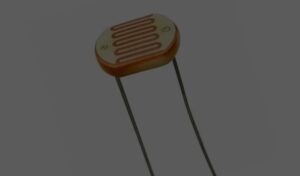A Light Dependent Resistor (LDR) is also called a photoresistor. The passive component is basically a resistor whose resistance value increases when the intensity of light decreases.
The resistor behaves depending upon the amount of light falling on it. In general, LDR resistance is minimum (ideally zero) when it receives a maximum amount of light and goes to maximum (ideally infinite) when there is no light falling on it. The resistance is very high in the darkness, almost high as 1MΩ but when there is light that falls on the LDR, the resistance is falling down to a few KΩ.
The vast majority of LDRs are made from cadmium-sulfide (CdS), and they are very cheap. They are very good at detecting changes in light levels and determining if it is ‘dark’ or ‘light’.

Light-dependent resistors come in different shapes and colors. LDRs are very useful in many electronic circuits, especially in alarms, switching devices, clocks, street lights and more. There are some audio application uses such as audio limiters or compressors. It is used to turn ON or OFF a device according to the ambient light.
How LDR Works
LDR has two wire leads that are connected to a face of the light detector. See the image above, the two metal dots we see are the ends of those 2 electrodes. The main body of the light detector component is made up of ceramic material which is an excellent insulator. On the face of the ceramic, a thin strip of cadmium sulphide is coated in a zig-zag pattern (to maximize the length of the strip while keeping the component small) which is connected at each end to an electrode. The front face is then coated in clear plastic, epoxy, glass, or similar material.
Cadmium-sulphide is a high resistance semiconductor and is chosen for light detectors as it gives the same spectral response as the human eye. It means cadmium-sulphide can ‘sees’ the same range of wavelengths of light that we humans can see. And it reacts to the light by increasing/decreasing the conductivity. Specifically, cadmium-sulphide is a photoconductive material. That means that photons of light hitting it with sufficient energy will release electrons from their atomic bonds resulting in providing higher conduction or lower conduction. When a negatively charged electron is freed by a photon of light, it leaves behind a positively charged ‘hole’. When a voltage is applied across the two-wire leads of the light detector, the free electron moves one way along the CdS strip, and the free ‘hole’ moves the other way; and it is this movement of charge which is electricity flowing through the light detector. The higher the light intensity, the more photons of light are hitting the CdS strip, the more electron-hole pairs are generated, the more electricity can flow through the light detector, and so the lower the resistance of the light detector. It is easier for electricity to flow through the light detector when the light intensity hitting it is high.
Electrically, it results in the increased or decreased resistance offered by the LDR.


